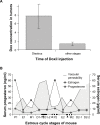Optimizing the time of Doxil injection to increase the drug retention in transplanted murine mammary tumors
- PMID: 20463938
- PMCID: PMC2865017
- DOI: 10.2147/ijn.s8488
Optimizing the time of Doxil injection to increase the drug retention in transplanted murine mammary tumors
Abstract
Sex hormonal milieus during the female fertility cycle modulate the tumor vascular permeability of breast cancer. It has been proposed that the liposomal formulated doxorubicin (ie, Doxil), given at the menstrual/estrous stage with the predicted highest tumor vascular permeability, allows significantly increased drug retention in the breast tumor. In the current study, syngeneic murine 4T1 mammary tumors were established on the backs of female BALB/c mice and Doxil was administered at particular mouse estrous cycle stages. The results indicated that Doxil administration during certain times in the mouse estrous cycle was crucial for drug retention in 4T1 tumor tissues. Significantly higher drug concentrations were detected in the tumor tissues when Doxil was administered during the diestrus stage, as compared to when the drug injection was given at all other estrous stages. Our study also showed that the tumor-bearing mice exhibited nearly normal rhythmicity of the estrous cycle post drug injection, indicating the feasibility of continual injection of Doxil at the same estrous cycle stage. By using 4T1 cells cultured in vitro, we showed that progesterone (P4) significantly inhibited cell proliferation and the production of six tumor-derived cytokines, eg, sTNF-RI, CXCL-16, GM-CSF, MIP-1alpha, MIP-1gamma, and Flt3-L. Some of these factors have been shown to be vascular modulators in diverse tissues. In this report, we demonstrated that the concentration of P4 in the plasma and/or estrous cycle stage of 4T1 tumor-bearing mice can be used to select the best time for administrating the liposomal anticancer drugs.
Keywords: Doxil; breast cancer therapy; menstrual cycle; mouse mammary tumor; progesterone.
Figures





Similar articles
-
Dose dependency of pharmacokinetics and therapeutic efficacy of pegylated liposomal doxorubicin (DOXIL) in murine models.J Drug Target. 2002 Nov;10(7):539-48. doi: 10.1080/1061186021000072447. J Drug Target. 2002. PMID: 12683721
-
Targeting CD44 expressing cancer cells with anti-CD44 monoclonal antibody improves cellular uptake and antitumor efficacy of liposomal doxorubicin.J Control Release. 2015 Dec 28;220(Pt A):275-286. doi: 10.1016/j.jconrel.2015.10.044. Epub 2015 Oct 27. J Control Release. 2015. PMID: 26518722
-
Extensive preclinical investigation of polymersomal formulation of doxorubicin versus Doxil-mimic formulation.J Control Release. 2017 Oct 28;264:228-236. doi: 10.1016/j.jconrel.2017.08.030. Epub 2017 Aug 24. J Control Release. 2017. PMID: 28844758
-
In vivo evaluation of a new polymer-lipid hybrid nanoparticle (PLN) formulation of doxorubicin in a murine solid tumor model.Eur J Pharm Biopharm. 2007 Mar;65(3):300-8. doi: 10.1016/j.ejpb.2006.10.022. Epub 2006 Nov 7. Eur J Pharm Biopharm. 2007. PMID: 17156986
-
Radiofrequency thermal ablation sharply increases intratumoral liposomal doxorubicin accumulation and tumor coagulation.Cancer Res. 2003 Oct 1;63(19):6327-33. Cancer Res. 2003. PMID: 14559820
Cited by
-
Effects of letrozole on breast cancer micro-metastatic tumor growth in bone and lung in mice inoculated with murine 4T1 cells.Clin Exp Metastasis. 2016 Jun;33(5):475-85. doi: 10.1007/s10585-016-9792-z. Epub 2016 May 21. Clin Exp Metastasis. 2016. PMID: 27209469
-
Novel chlorambucil-conjugated anionic linear-globular PEG-based second-generation dendrimer: in vitro/in vivo improved anticancer activity.Onco Targets Ther. 2016 Sep 7;9:5531-43. doi: 10.2147/OTT.S103487. eCollection 2016. Onco Targets Ther. 2016. PMID: 27660471 Free PMC article.
-
Advancing cancer gene therapy: the emerging role of nanoparticle delivery systems.J Nanobiotechnology. 2025 May 20;23(1):362. doi: 10.1186/s12951-025-03433-8. J Nanobiotechnology. 2025. PMID: 40394591 Free PMC article. Review.
-
Calcium dobesilate prevents PLD-induced hand-foot syndrome by alleviating capillary endothelial tight junction injury via the HA/CD44 pathway.Am J Cancer Res. 2023 Jul 15;13(7):3234-3245. eCollection 2023. Am J Cancer Res. 2023. PMID: 37559988 Free PMC article.
-
Ultrasound sonication with microbubbles disrupts blood vessels and enhances tumor treatments of anticancer nanodrug.Int J Nanomedicine. 2012;7:2143-52. doi: 10.2147/IJN.S29514. Epub 2012 Apr 24. Int J Nanomedicine. 2012. PMID: 22619550 Free PMC article.
References
-
- Matsumura Y, Maeda H. A new concept for macromolecular therapeutics in cancer chemotherapy: mechanism of tumoritropic accumulation of proteins and the antitumor agent smancs. Cancer Res. 1986;46:6387–6392. - PubMed
-
- Sledge GW, Jr, Miller KD. Exploiting the hallmarks of cancer: the future conquest of breast cancer. Eur J Cancer. 2003;39:1668–1675. - PubMed
-
- Wu J, Akaike T, Maeda H. Modulation of enhanced vascular permeability in tumors by a bradykinin antagonist, a cyclooxygenase inhibitor, and a nitric oxide scavenger. Cancer Res. 1998;58:159–165. - PubMed
-
- Lamprecht A, Ubrich N, Yamamoto H, et al. Biodegradable nanoparticles for targeted drug delivery in treatment of inflammatory bowel disease. J Pharmacol Exp Ther. 2001;299:775–781. - PubMed
-
- You S, Li W. Administration of nanodrugs in proper menstrual stage for maximal drug retention in breast cancer. Med Hypotheses. 2008;71:141–147. - PubMed
Publication types
MeSH terms
Substances
LinkOut - more resources
Full Text Sources
Other Literature Sources
Miscellaneous

